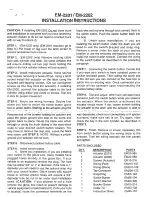
Pro
te
c
t
ed
b
y
co
p
y
rig
h
t.
C
o
p
y
in
g
fo
r
pr
iv
a
t
e
o
r
c
o
m
m
e
r
c
ia
l
p
u
rp
o
s
e
s
,
i
n
p
a
rt
o
r i
n
w
h
o
le
,
is
n
o
t
p
e
r
m
it
t
e
d
u
n
l
e
s
s
a
ut
ho
r
i
s
ed
b
y
V
olk
sw
a
ge
n AG
.
V
olk
s
w
a
g
en
AG do
es
n
ot g
uar
ante
e
or a
c
c
ep
t
a
ny
li
a
b
i
li
t
y
w
ith
r
e
s
p
e
c
t
t
o
th
e
c
o
rr
e
c
t
n
e
s
s
o
f
in
fo
r
m
a
tio
n
in
th
is
d
o
c
um
en
t.
C
o
py
rig
ht b
y
V
olk
sw
a
ge
n
A
G.
5
Start/stop system
⇒ “5.1 General description - start/stop system”, page 29
⇒ “5.2 Removing and installing voltage stabiliser”, page 30
5.1
General description - start/stop system
General description:
The start/stop system is used for reducing fuel consumption by
automatically switching off the engine when the vehicle is sta‐
tionary and automatically starting it when the driver wants the
vehicle to move on. The start/stop mode is automatically activated
when, after starting to move, the vehicle is driven for about 4 sec‐
onds at a minimum speed of 3 km/h.
Following control units are involved in the start/stop system:
♦ Data bus diagnostic interface - J533- in the onboard power
supply control unit - J519-
♦ Engine control unit - J623-
♦ ABS control unit - J104-
Recharging battery or jump start on vehicles with start/stop sys‐
tem:
When recharging or jump starting vehicles with start/stop system,
note the following: first connect charging cable to battery positive
terminal then body earth. This ensures that the battery sensor is
not bridged. The direct charging of the battery on the negative
terminal clamp means that the battery sensor is shunted and the
battery data are not registered by the sensor while charging.
Then, the values concerning the battery state and saved in the
data bus diagnostic interface would not correspond to the values
of the charged battery.
Replacing battery on vehicles with start/stop system:
Because of its higher deep-cycle resistance, only a special starter
battery is used in vehicles with a start/stop system.
When renewing the starter battery, note correct part designation
in ⇒ ETKA (electronic parts catalogue) . Starter batteries for use
in vehicles with a start/stop system are marked with “AGM” (Ab‐
sorbent Glass Mat) or “EFB” (Enhanced Flooded Battery).
Fault detection and fault display:
The start/stop system as a function is integrated in the engine
control unit - J623- software.
The engine control unit - J623- features self-diagnosis to facilitate
fault finding.
To localise faults, refer to chapter entitled “Vehicle diagnosis,
testing and information system” and use “Guided fault finding”
function.
The voltage stabiliser - J532- is secured on the floor covering un‐
der the left front seat. It has the task of stabilizing to 12 volts the
high voltage fluctuations generated in the onboard supply by the
start/stop operation.
Effects in case of voltage stabiliser failure:
If the voltage stabiliser is defective, devices such as the radio,
radio navigation or telephone will perform a reset if their own volt‐
age supply is not sufficient when the starter is operated. If, in start/
stop mode, the mentioned electrical consumers are identified as
causing a reset for each motor start, this indicates a defective
voltage stabiliser. At present, no direct entries can be made con‐
cerning malfunction of the voltage stabiliser, e.g. in the event
up! 2012 ➤
Electrical system - Edition 03.2017
5. Start/stop system
29
















































